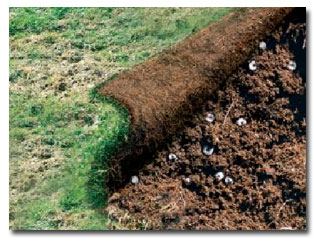The Dangerous Underground

How to Handle Lawn Grubs
It’s backyard picnic time again and if you’re like most people, you want your lawn to be beautiful. Unfortunately, there’s a horde of hooligans just under the surface that has a different plan. Meet the lawn grubs. They’re ready for a summer picnic too, and the results are a lawn with brown, dead patches.
The Circle of Life
Lawn grubs, also known as white grubs, are actually young scarab beetles (Japanese beetles, June “bugs”, or European chafers). These larval forms are C-shaped, white and soft-bodied with legs near their heads. The roots of your grass, as well as other organic matter in the soil, are their favorite food; their feeding causes brown, dead sections in your lawn.
These characters typically wake up in spring to feed. Then they pupate, becoming adult beetles in summer. These beetles eat your flowers and garden greens. Mating season usually happens in early- to midsummer and lasts about two to three weeks, after which the females lay eggs in your lawn. If temperature and soil moisture are in the correct balance, the eggs hatch into grubs in mid- to late summer and the cycle begins again. The new grubs tend to stay just a few inches below the surface. However, they burrow deeper before winter hits.
Got Grubs?
There are ways of determining if your lawn is under attack. In spring as your lawn is greening, look for brown, dead spots. These may be indicative of grub feeding from the previous year. Lift up a piece of your turf to confirm the damage. If it’s due to grub feeding, the dead spot should roll up like a rug. Alternatively, you can pull up some of the grass; if it has no roots, you’ve been “grubbed.”
If you’re keeping your lawn well-watered, current infestations show up as oddly-shaped dead spots in late summer or early fall. Test these spots using the method mentioned above.
If your lawn is under siege by birds, skunks, armadillos, raccoons and moles, you may have grubs. These animals love eating grubs and have no problem wrecking your lawn to find them. They also eat earthworms, so be sure to double-check that it’s a grub infestation before treating.
Take a walk across your lawn; be on the lookout for “spongy” areas. If you’re keeping your lawn well-watered, “sponginess” sometimes occurs before the brown spots and may be an early clue to a grub infestation.
To Treat or Not To Treat
If you find “spongy” spots, you need to do some further investigation to determine if grubs are present and, if so, how badly you’ve been infested. Investigate by digging one square foot sections of sod about two to four inches deep; you’ll see the grubs if they’re there.
Not every infestation requires treatment. The typical healthy lawn can support as few as zero to five and as many as ten or more grubs per square foot. Remove any grubs you find, toss them into a bucket of soapy water, and water the areas of turf you lifted once it’s back in place.
You can plan to treat (or not) based on the results of your treatment triage. If you find:
- 0-5 grubs: Treatment is unnecessary.
- 6-9 grubs: Unless your lawn is being ravaged by animals, treatment is unnecessary if your lawn is healthy. You could treat high-use/high visibility areas, leaving the rest alone. Unhealthy lawns need treatment.
- 10 or more grubs: Treatment is a must. Populations this dense will most likely cause your lawn visible damage.
Timing is Everything!
The best time to treat using pesticides is mid- to late summer and early fall; the grubs are newly hatched and most susceptible to treatment. There are two categories of treatment available: Curatives and Preventatives.
Curative products kill the current infestation on contact. Preventative products kill the current infestation when you apply the treatment as well as any new hatchlings that season. Be careful with the preventative products though; these contain nitrogen fertilizer and your lawn will burn during the hot days of summer without proper watering. Your local Grangetto’s can give you the best advice on which product to apply.
Tips and Tricks for Successful Treatment
- Watch your neighbors’ grass. If a neighbor has a grub infestation, the adult beetles will probably migrate.
- Grubs gravitate toward moist soil. Female beetles head for moist ground as more eggs will hatch and the grubs will develop better.
- Water after treating. You can use the fact that grubs like moisture to your advantage; watering gets the pesticide further into the ground and attracts deeper-burrowed grubs to rise.
- Reseed the dead areas to restore your lawn.











